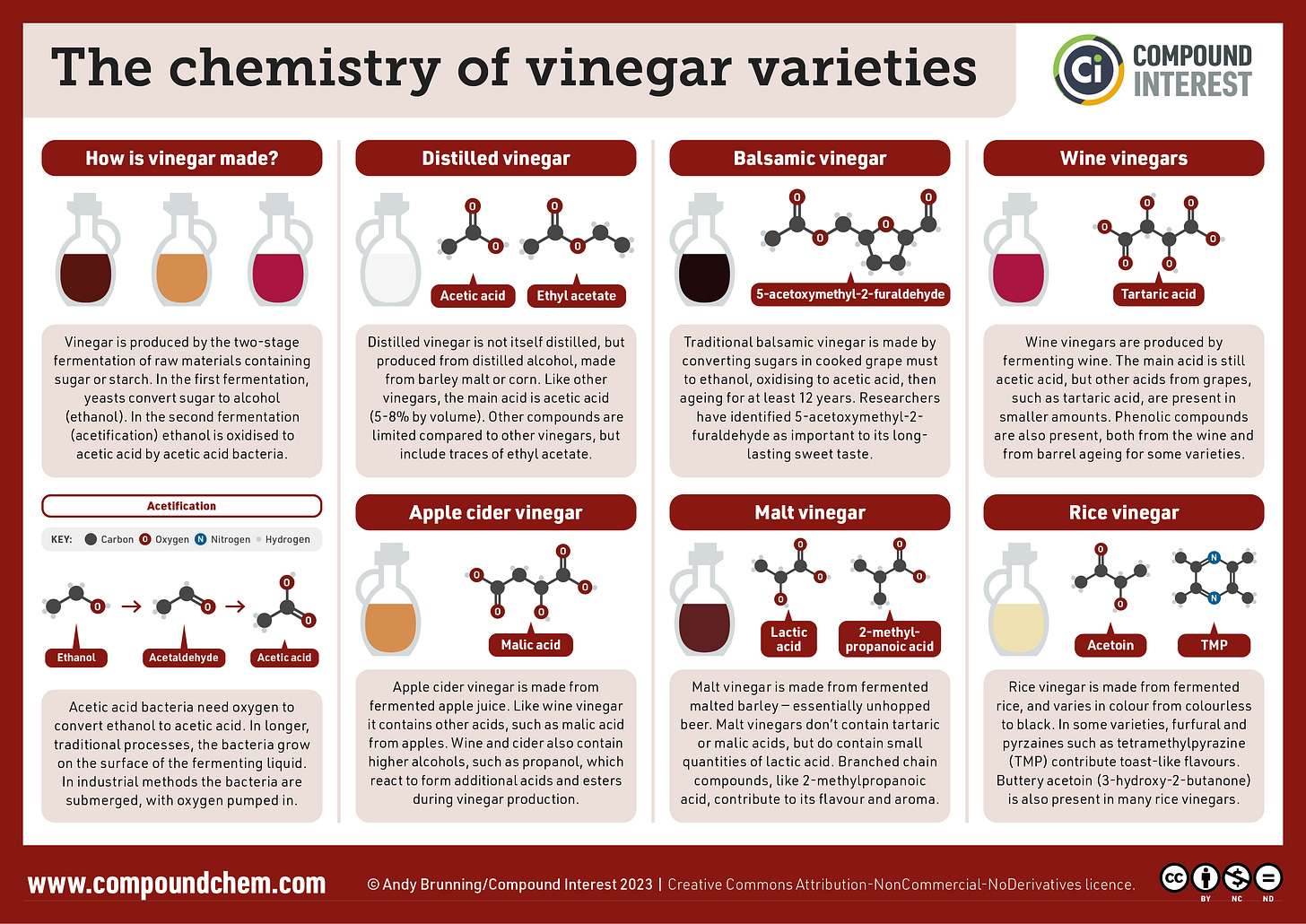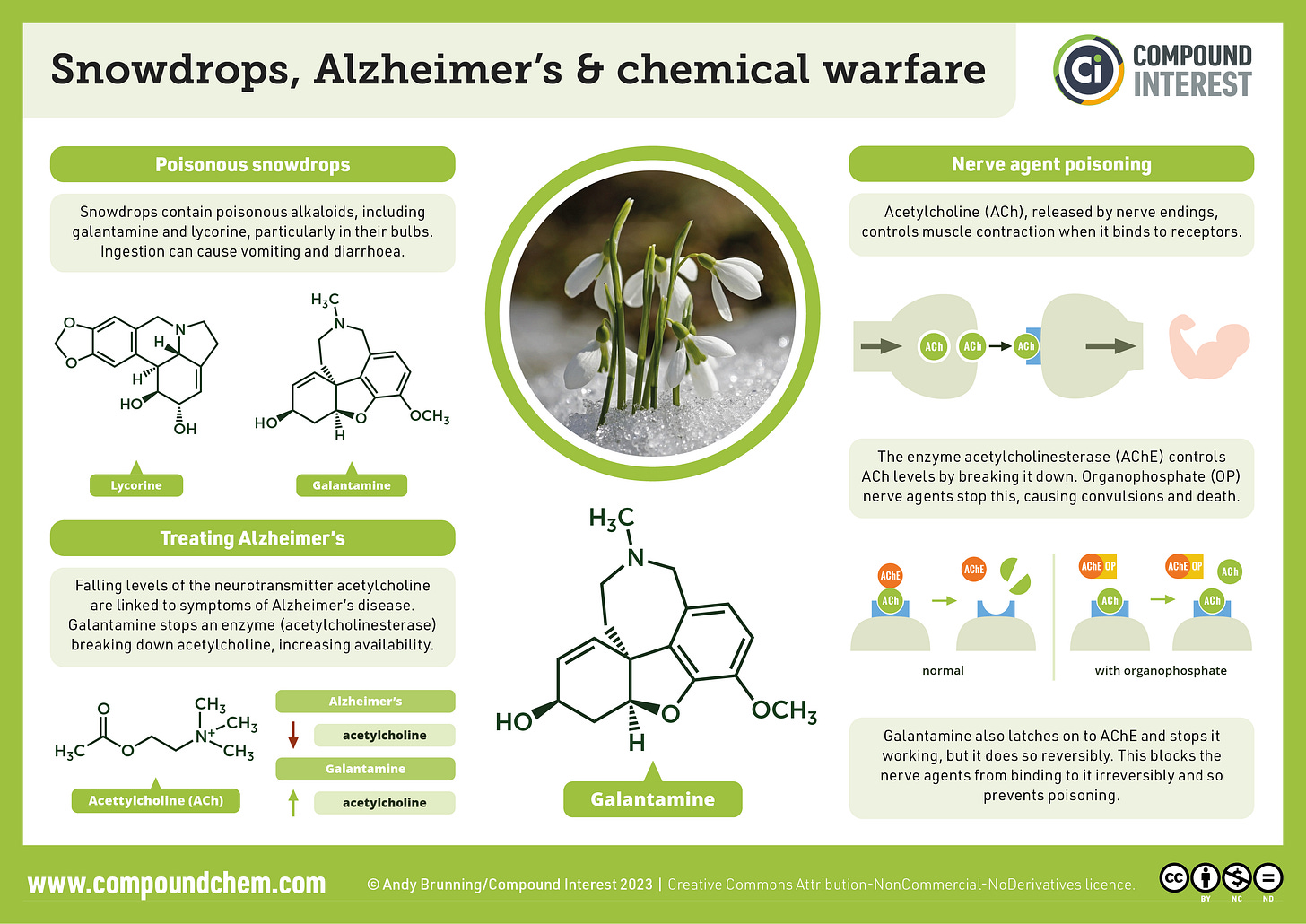Periodycal #7: Vinegars, snowdrops, and Arrhenius
Also, what links Arrhenius and cherry blossoms?
Welcome to another edition of Periodycal, the Compound Interest newsletter. This edition features a look beyond acetic acid in vinegars to the other compounds that contribute to their characters, a refresh of a graphic explaining the link between seasonal snowdrops and chemical warfare, and a surprising link between the Arrhenius equation and cherry blossom season. As well as that, there’s the usual round-up of upcoming events and relevant chemistry, along with a summary of interesting recent chemistry news and features.
The sour science of vinegar varieties
Vinegars are all acetic acid, when it comes down to it, but there are other compounds which contribute to their unique characters, differentiating your balsamic vinegars from your malt vinegars and so on. This graphic takes a look at some selected examples.
I spent ages poring over papers and other reference materials for this one, and had to do some deep digging for some of the vinegar types. It was surprisingly difficult to find much interesting about malt vinegar, for example! Worth checking out the accompanying post on the website, which includes mention of vinegar eels — if I have to know about them, so do you.
Snowdrops, Alzheimer’s, and chemical warfare
It’s snowdrop season here in the UK, so I’ve given this old graphic on snowdrop science a little spruce up. Galantamine, a compound found in snowdrops, has some unexpected links to both Alzheimer’s disease and chemical warfare, as the graphic and accompanying post detail.
Arrhenius and cherry blossom
The most recent addition to the occasional chemistry history series of graphics highlights the contributions of Svante Arrhenius and his eponymous equation.
While it’s already been and gone, I thought it still worth highlighting in this newsletter because of an unexpected link with Japan’s cherry blossom season. Several commenters highlighted that the advance of cherry blossoms across Japan is predicted using the Arrhenius equation, as detailed in this paper – a brilliant piece of context to share if you happen to be teaching about the equation!
While we’re on the topic of chemistry history graphics, thanks for those of you who suggested topics with additional dates for future editions. The form’s still open if you had other suggestions. I’m slowly adding all the graphics in the series so far to this summary page – not quite added all of them yet, and will eventually ensure they’re all in the newest graphic format, but they’ll all be there eventually.
Upcoming chemistry tie-ins
Here’s a quick run-down of upcoming events or days and links to some relevant chemistry graphics from the archives:
27 February: National Strawberry Day — The chemistry of strawberries (in C&EN)
28 February: Linus Pauling’s birthday — Linus Pauling and electronegativity
2 March: Discovery of radioactivity — A guide to the different types of radiation
3 March: National Mulled Wine Day — The chemistry of mulled wine
6 March: National Dentists Day — The chemistry of dentistry (in C&EN)
Chemistry news and features
Here’s the regular round-up of chemistry news and features I’ve found interesting over the past couple of weeks:
The derailment of a freight train carrying vinyl chloride and other chemicals in East Palestine, Ohio, has caused concern and frustration in the past few weeks. C&EN summarise the concerns and the questions that still remain.
Organolithium compounds are moisture- and air-sensitive reagents that require careful handling. Researchers have now managed to encapsulate them in low-cost gels, stabilising them and making them safer to use.
That’s all for this edition! As always, I always appreciate any feedback or suggestions, both for the newsletter or new graphic topics. Let me know in the comments below.
Thanks for reading,
Andy








Hi Andy! Last night we were talking about Armand Duplantis and his world pole vault record in Oregon. That makes me think about what are pole vault made of... It would be an interesting post for Periodycal Newsletter. Sorry but my English is bad.
Your posts are amazing! Thanks!